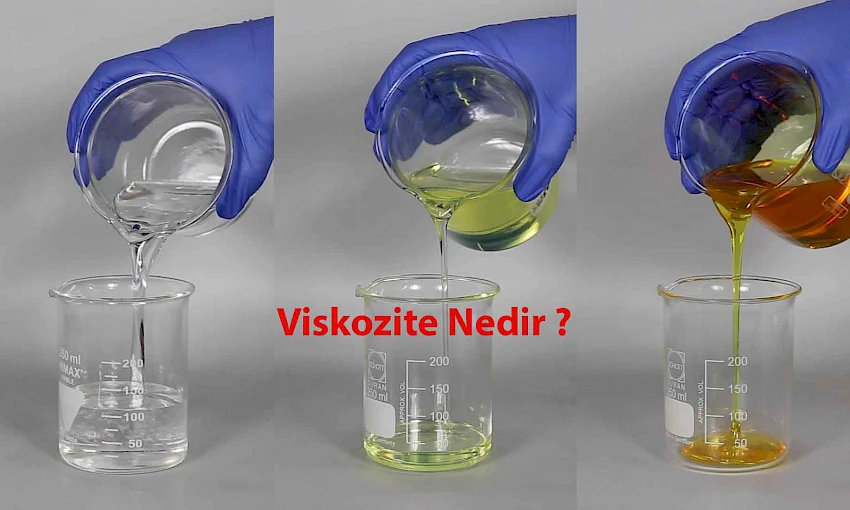
What is Viscosity?
Viscosity is a physical property that defines a fluid's internal resistance to flow and its level of resistance to deformation under stress. More technically, viscosity refers to the resistance a fluid exhibits against shear stress, caused by interactions between its molecules. In the SI unit system, it is expressed in Pa·s (Pascal-seconds) or the more commonly used cP (centipoise).
1️⃣ Dynamic Viscosity:
Dynamic viscosity (μ) measures a fluid's resistance to shear stress and is expressed using Newton's viscosity law with the formula:
τ = μ * (du/dy)
Where:
-
τ: Shear stress per unit area
-
μ: Dynamic viscosity (Pa.s or N.s/m²)
-
du/dy: Velocity gradient (rate of velocity change with respect to distance)
2️⃣ Kinematic Viscosity:
Kinematic viscosity (ν) refers to a fluid's flowability, which depends on its density, and is calculated as:
ν = η / ρ
Where:
-
ν: Kinematic viscosity (m²/s)
-
μ: Dynamic viscosity (Pa.s)
-
ρ: Density (kg/m³)
Differences Between Dynamic and Kinematic Viscosity
1️⃣ Definition:
-
Dynamic viscosity (μ): Describes the internal friction of a fluid, i.e., its resistance to shear stress.
-
Kinematic viscosity (ν): Represents the ratio of dynamic viscosity to density, indicating the fluid's flowability.
2️⃣ Formulas:
-
Dynamic viscosity: τ = μ * γ
-
Kinematic viscosity: ν = μ / ρ
3️⃣ Units:
-
Dynamic viscosity: Measured in Pascal-seconds (Pa·s) or centipoise (cP) in the SI system.
-
Kinematic viscosity: Measured in square meters per second (m²/s) or centistokes (cSt).
4️⃣ Applications:
-
Dynamic viscosity: Used to determine the internal friction properties of fluids like lubricants, polymers, and liquid metals.
-
Kinematic viscosity: Used to analyze flow characteristics of fluids in hydraulic systems, fuels, and lubricants.
5️⃣ Key Difference:
Dynamic viscosity reflects the internal friction of the fluid, while kinematic viscosity measures the fluid's flowability based on its density. Both parameters are crucial in industrial and engineering applications for fluid selection and system design.
Dynamic Viscosity and Density Values of Chemicals
-
Flexible Polyester Resin
-
Viscosity: 300–350 [Pa.s, 25°C]
-
Density: 1.10 g/cm³
-
-
Saturated Polyester Resin
-
Viscosity: 1,200–3,500 [Pa.s, 25°C]
-
Density: 1.093 g/cm³
-
-
-
Viscosity: 100–225 [Pa.s, 25°C]
-
Density: 40 kg/cm³
-
-
Acrylic Resin
-
Viscosity: 2,000–5,000 [Pa.s, 25°C]
-
Density: 1.54 g/cm³
-
-
Isocyanate
-
Viscosity: 200–450 [Pa.s, 25°C]
-
Density: 1.14 g/cm³
-
-
Hydrochloric Acid
-
Viscosity: 1.7 [Pa.s, 20°C]
-
Density: 1.18 g/cm³
-
-
Sodium Hypochlorite (HYPO)
-
Viscosity: 6.4 [Pa.s, 20°C]
-
Density: 1.11 g/cm³
-
-
Sodium Carbonate
-
Viscosity: 3.4 cP [Pa.s, 887°C]
- Density: 2.54 g/cm³
-
-
Acrylic Acid
-
Viscosity: 1.19 [Pa.s, 20°C]
-
Density: 1.05 g/cm³
-
-
-
Viscosity: 63 [Pa.s, 20°C]
-
Density: 0.984 g/cm³
-
-
-
Viscosity: 500–8,000 [Pa.s, 20°C]
-
Density: 0.93 g/cm³
-
-
Polyvinyl Alcohol
-
Viscosity: 4–47 [Pa.s, 25°C]
-
Density: 1.19 g/cm³
-
-
-
Viscosity: 400–800 [Pa.s, 20°C]
-
Density: 0.8 g/cm³
-
-
-
Viscosity: 40–340 [Pa.s, 25°C]
-
Density: 1 g/cm³
-
-
-
Viscosity: 2.20–1,500 [Pa.s, 40°C]
-
Density: 0.8–0.9 g/cm³
-
-
Thinner
-
Viscosity: 1.063 [Pa.s, 40°C]
-
Density: 0.86–0.87 g/cm³
-
-
Varnish
-
Viscosity: 10–15 [Pa.s, 25°C]
-
Density: 0.93–0.97 g/cm³
-
-
Water-Based Paint
-
Viscosity: 75–85 [Pa.s, 25°C]
-
Density: 1.4 g/cm³
-
-
Solvent-Based Paint
-
Viscosity: 95–105 [Pa.s, 25°C]
-
Density: 1.3 g/cm³
-
-
Hydrogen Peroxide
-
Viscosity: 1.245 [Pa.s, 20°C]
-
Density: 1.11 g/cm³
-
-
Sodium Hydroxide (Caustic Soda)
-
Viscosity: 4 [Pa.s, 350°C]
-
Density: 1,320–1,520 kg/m³
-
Writer:
Professor Doctor Mustafa Yaşar
Industrial Design Engineer





































